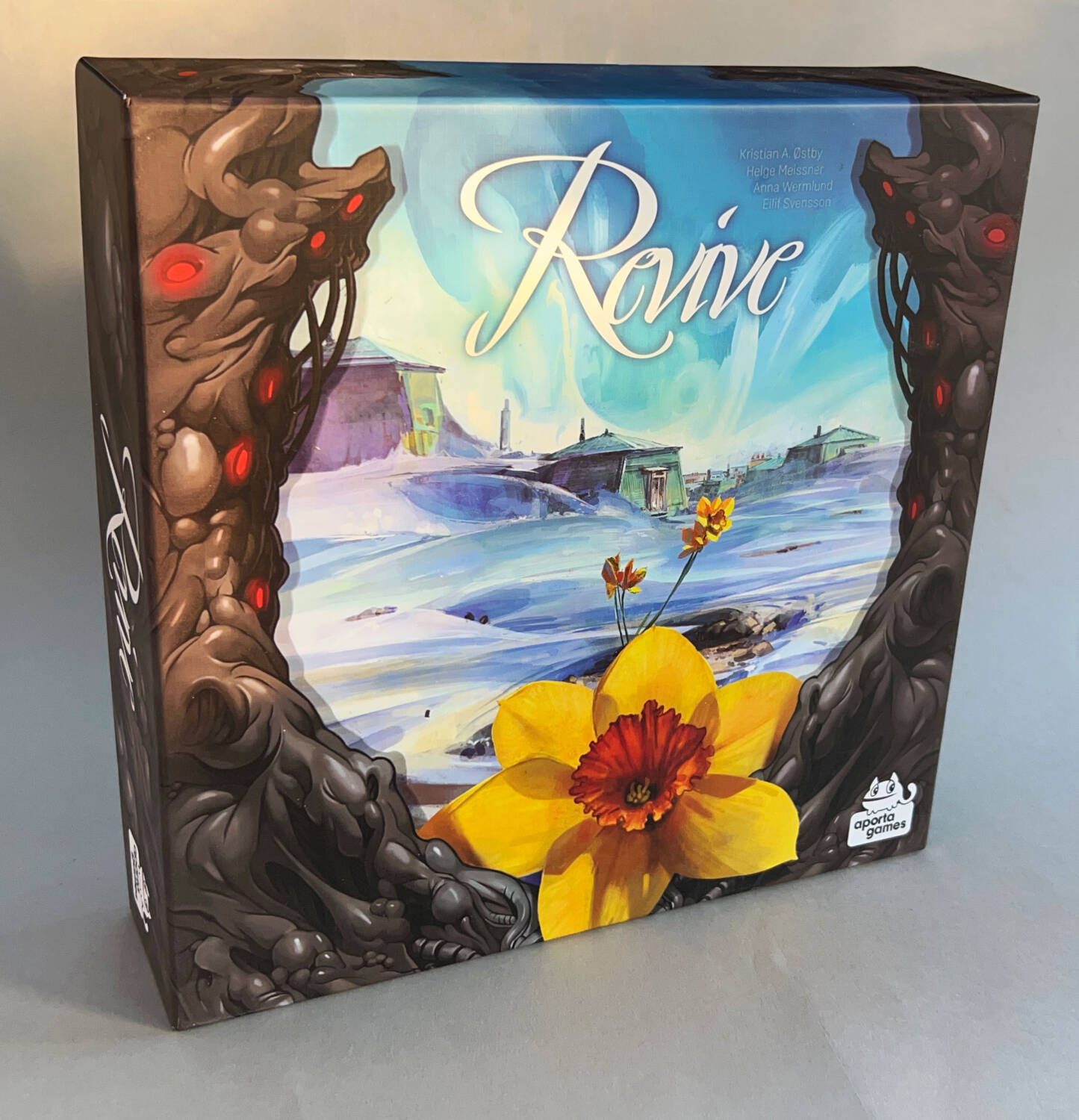
Intro
Five thousand years ago, The Devastation took hold of the planet as temperatures dropped. Ice replaced the planet’s once thriving ecosystems. Thick ice. Deep ice. Civilization, or rather, those few surviving tribes, went underground to await The Great Thawing that they hoped would one day come.
Or something like that.
The rule book for Revive is short on backstory—short as in non-existent. With regard to gameplay, however, the narrative is as unclear as it is unnecessary. This is an exploration/deckbuilder/worker placement game, pure and simple. But, does a lack of backstory mean the gameplay wasn’t well-thought out as well? Read on to find out!
Setup
In Revive, you’re working to rebuild the planet and restore your tribe better than your opponents. When the game ends, you’ll review your progress, tally your scores, and the player with the most points wins.
Each player will have a slightly asymmetric faction board to represent their tribe. You’ll populate the central area of this board with seven meeple and five scoring tokens. Along the left edge, you’ll place three big buildings and five smaller buildings.
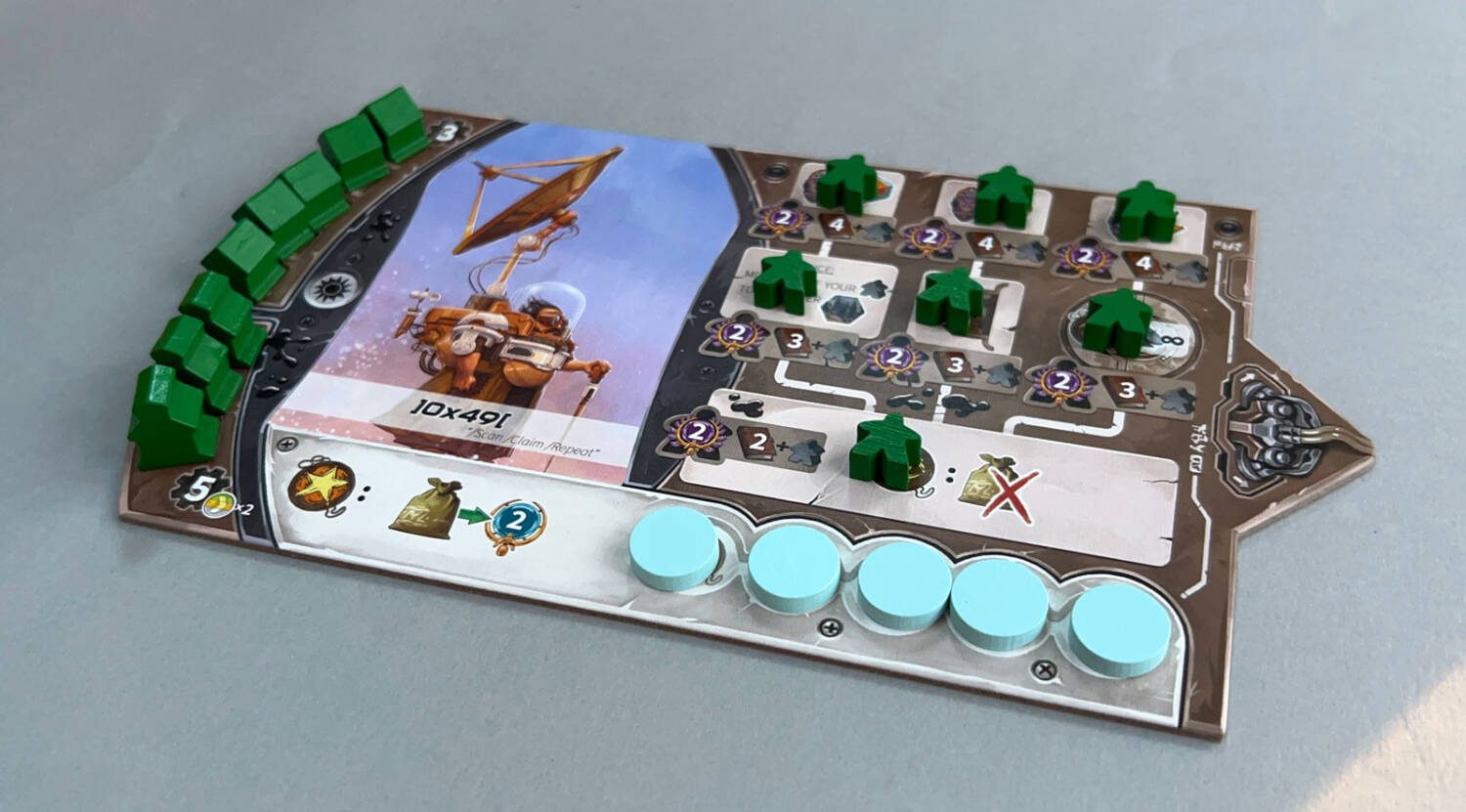
That faction board will fit into the left side of your Machine (main player action) board. Your Machine board has two areas for cards along the top two along the bottom. A lone slot sits in the upper right to be unlocked later in the game. At the bottom right are four tracks. This is where you’ll keep track of how many of the game’s resources you have at any time: Gears, Books, Food, and Crystals.The main part of your Machine board is a confusing maze of inter-connected lines and circles in green, yellow, and gray: your Machine. Through actions you’ll take during the game, you’ll be able to unlock additional actions and bonuses.
You’ll also get six starting cards. Shuffle these and randomly put three of them in the inset area on the right side of your Machine board. Lay the remaining three out, face up. These will be your starting cards for your first round of actions.
The central playing board, common to all players, represents the planet’s surface. You’ll place six starting tiles, face up, surrounding The Crater—the center hex on the board that represents the starting point for the planet’s rejuvenation.
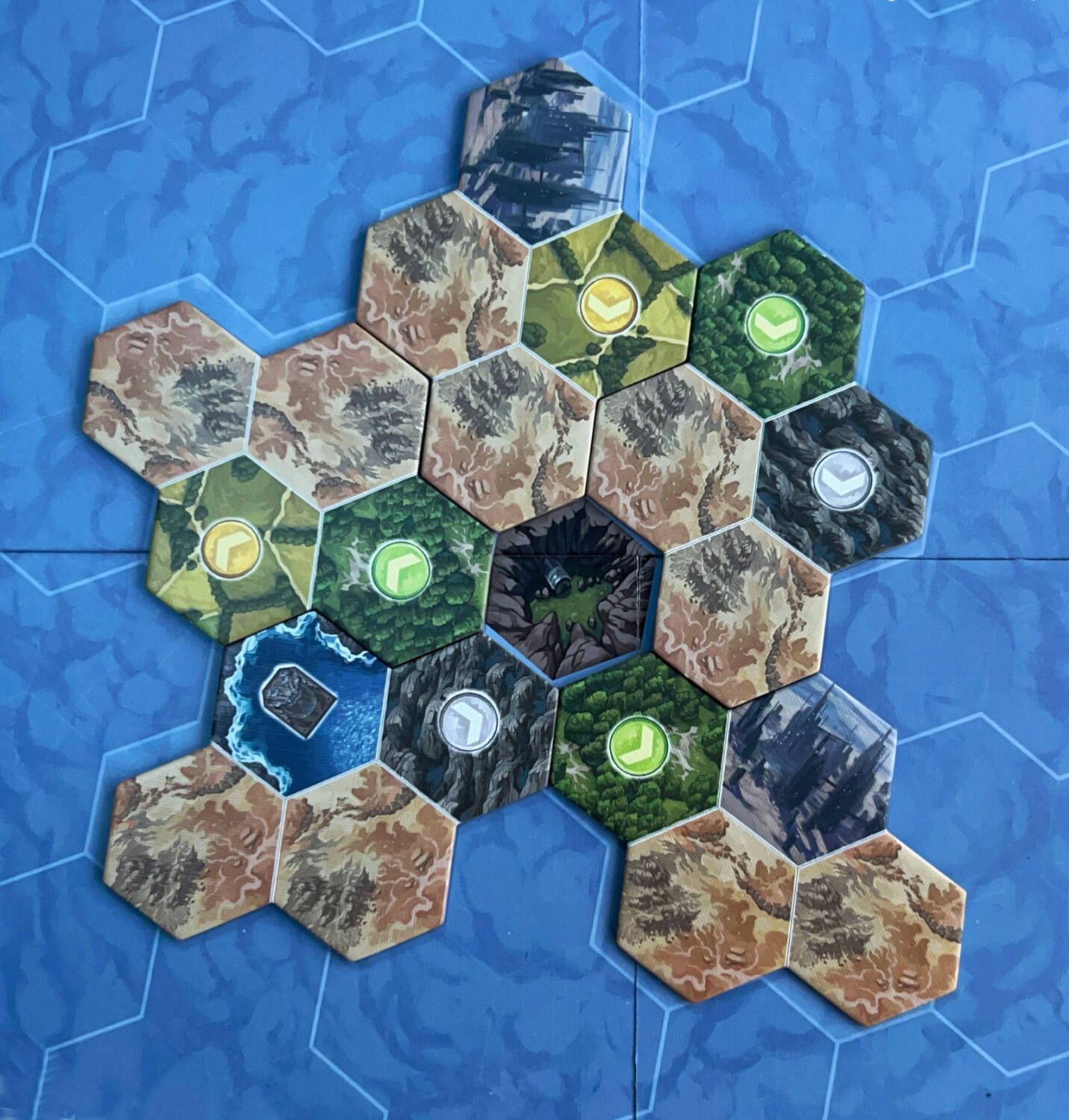
The remaining tiles are mixed and placed face down to be explored as the game progresses. Mix the five large tiles, then choose four and place them at the corners of the board to allow for additional scoring bonuses.
Gameplay
On a turn, you’ll take two actions: these can either be two separate actions or you can repeat a single action. Playing a card to gain the resources shown on the card, for instance, is an action. And since you’ll need those resources—Gears, Books, Food, or Crystals—to pay for actions on either the main board or your faction’s board, your first turn will include playing a card. You can play a card into an open space at the top of your Machine board to claim the resources at the top of the card, or you can place it in a bottom space to claim the bottom resource or action.
Each of these card areas has room for two or three slot tokens, which you can gain throughout the game. These tokens have one or two background colors and a resource on them. You’ll place them in one of the open slots in a card area. From then on, when you play a card there that matches the color on the token, you’ll get a bonus of the shown resource.
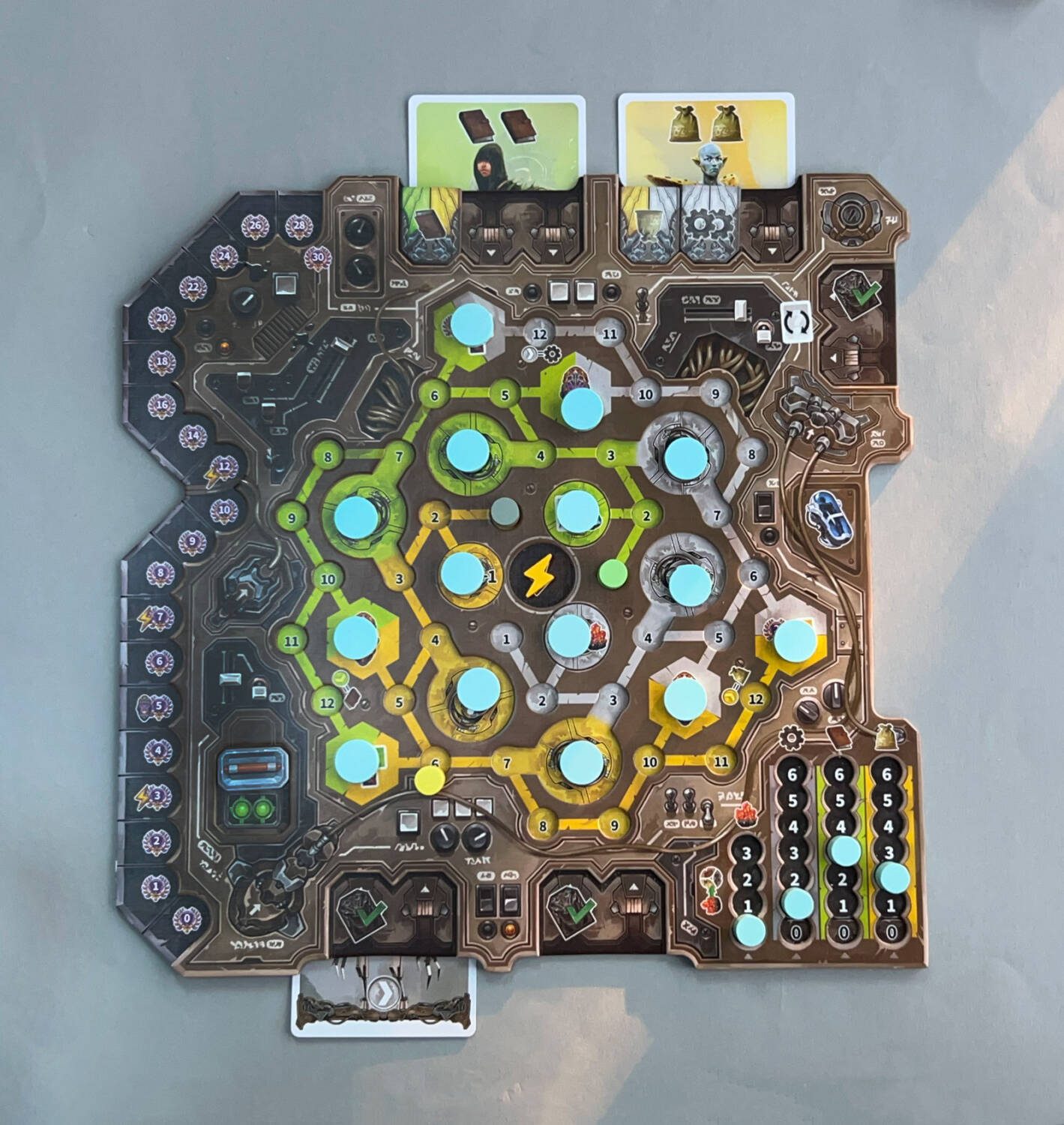
Before doing much else, you’ll need to understand Range. In Revive, you must pay cost to reach another hex on the common board from where you’re starting from. Initially, Range starts at the Crater. You’ll count the number of hexes you must cross before getting to your intended hex or tile, then pay Food equal to the Range. Once you have built or populated (see below), you will calculate your Range from your nearest piece on the board, be it a building or a meeple.

The Explore action allows you to turn over an ice tile on the board to its revived land side—and gains you an additional card for your personal deck. After turning the tile over, you get to decide how to position the tile on the board. This choice is important for the Build action. Building next to a green, yellow, or gray hex advances you on that track in your Machine, Building a small building will get you the Machine movement/bonus once; building with a large building and you’ll double it. To Populate, pay the Books required for that meeple. This then gives you three paths you’ll take to place other meeple on the common board, unlocking different actions or abilities at increased costs in Books. he last action is to use the Switch on your board..Move it down and you can claim one of the common resources and add it to your personal resource track.
When you have no more actions, or have decided to stop taking actions for the round, you Hibernate. This allows you to take all the face-down cards from the right side of your board into your hand and to move all your played cards from around your Machine board and place them face-down into your holding area. (Any unplayed cards remain in your playing area.)
There are also some free actions you can take on a turn. For instance, you power your Machine by using lightning bolt tokens. When you have uncovered or added an action/resource option to your Machine, at any time during your turn you can place an available lightning bolt on that spot and take the action/resource shown. Throughout the game, you’ll have chances to gain additional lightning bolts and you can use as many as you’d like on a turn, even repeating the same free action.
Along the top edge of the board you’ll have a number (based on player count) of Major Artifact tokens. When someone claims the last of these, the remaining players get a last turn and the game ends.
Scoring
During the game, you will score three types of publicly known points. One of these is on a blue background (earned when turning over ice tiles, for instance) and you will score them on the left side of the common board. Light blue discs cover part of your faction board and spots around your Machine. When you remove these, they go along the left edge of your Machine board, scoring you (purple background) points—as well as unlocking bonuses. When you populate, each meeple is worth the points shown when you remove the meeple.
Your final points will come from the secret Artifact card you’ll get at the start of the game. This will show the three colored Major Artifacts, with each one paired with an element within the game: new cards gained during the game, lightning bolts, slot tokens, etc. The Major Artifact on the card counts as one, so in the case of lightning bolts, you would score one additional point for each of your lightning bolts at the end of the game. Each Major Artifact you claim of that color will multiply those points. Even if you only claim one, that one, along with the Major Artifact on the card, will mean two times that number.
Legacy Aspects
Revive comes with several legacy elements that are unlocked after subsequent playthroughs. These include two new factions, the rules for playing on the back side of your faction board, and other additions to keep the game fresh. I had read that, if nothing else, we should adopt the change to using the Switch that is available after the first game. Keeping this review spoiler-free, I’ll just say we all agreed it was a much better rule and we’ve used it in all our games since.
Are the legacy components and changes necessary? Not really. However, if you’re looking for more game, they’re a good starting point. You can use all or some of them without unbalancing the game.
Thoughts
The Brief Not So Goods
Before going into why I like Revive so much, let me get my two issues with the game out of the way.
- The turn summary cards were only useful after players became familiar with the game—leaving more questions than there should have been for the first several turns. I’m all for language-independent artwork and symbols, but players still need to understand the information presented. Larger cards with written explanations would have helped a lot.
- Revive is not color blind friendly at all. This is a real missed opportunity—the art team could have easily come up with symbols and patterns for the three colors. The yellow, green, and gray colors are so muted, causing more than one color question about the gray cards from my non-colorblind group.
The Longer Why This Game is So Great
My first action in my first game felt disappointingly pre-determined: I had no resources to do anything, so my first action had to be playing a card to get them. Looking at my options, I played a second card for more starting resources.
It took me a few plays to realize I didn’t need to approach Revive from an ‘I Must Acquire All The Resources Before Acting’ mentality. After all, you’re limited to only six of any common resources (and four Crystals) on your trackers. Did I need to gain resources as my very first action? Yes. Did I absolutely need more resources as a second action? Not necessarily.
Depending on the random way the starting tiles and the face-down ice tiles were laid out, there are often opportunities for additional actions. Want to Explore a nearby tile to score some early points and add cards to your deck? If you have the necessary Food, you can do so on the second part of your first turn. If a City hex is next to the Crater, you could Populate. Since everyone starts the game with one Crystal (a wild resource), you could even build a small building on your first turn.

In our games of Revive, we’ve each taken different approaches to playing. They’ve each worked well for us, with final scores being within points of one another. Exploring, which gets you (points and) an additional card in our hand, gives you more opportunities for resources or actions, and will ensure you’ll have more than just three cards to use in a turn. Populating opens up your faction’s special ability, one that benefits you by altering the rules in your favor. It also opens up other opportunities, either ongoing actions or ones that you can power by lightning bolts as free actions.
If you Build, you’re going to progress along your Machine’s tracks. This not only scores you points along the edge of your Machine board (that grant occasional bonuses) but often exposes options for additional free actions—or allows you to choose a free action to add to your Machine. Six of the circles on your Machine, when exposed, show question marks. This means you can choose from one of three face-up Machine tokens, based on the color of the track you’re one, and insert it into your Machine.
I need to take a moment to appreciate the game-changing flexibility Free Actions provide. Without them, Revive would be just another lackluster resource management game where you’re constantly preoccupied with your lack of resources and the lack of opportunities to get those resources.
Between acquiring good slot modules for additional resources, the collecting lightning bolts, and Machine tokens to play them on, most of your turns will be productive ones. You may not do exactly what you want to do on every turn, but you’ll never be frustrated by a lack of agency.
Free Actions can easily turn standard turns into lengthy ones. To once again, borrow a phrase from my friend and fellow Meeple Mountain colleague Justin Bell, Free Actions allow for some serious combolicioius turns. Recognizing this, the game includes two wooden blocks to place on your turn summary card to keep track of how many actions you’ve taken on a turn. At first, we thought that this was both silly and unnecessary. Halfway through our first game, we dug out pairs of d6s to mark off our turns because the combos were getting so entangled that we had forgotten if that was our first action or our second.
Revive is a game that I only heard about through two Best Games of 2023 lists. Apparently, distribution issues kept it from being better known, which is a shame. If you like deckbuilders, exploration and worker placement games, and games with plenty of combolicious opportunities, you should definitely look into Revive.


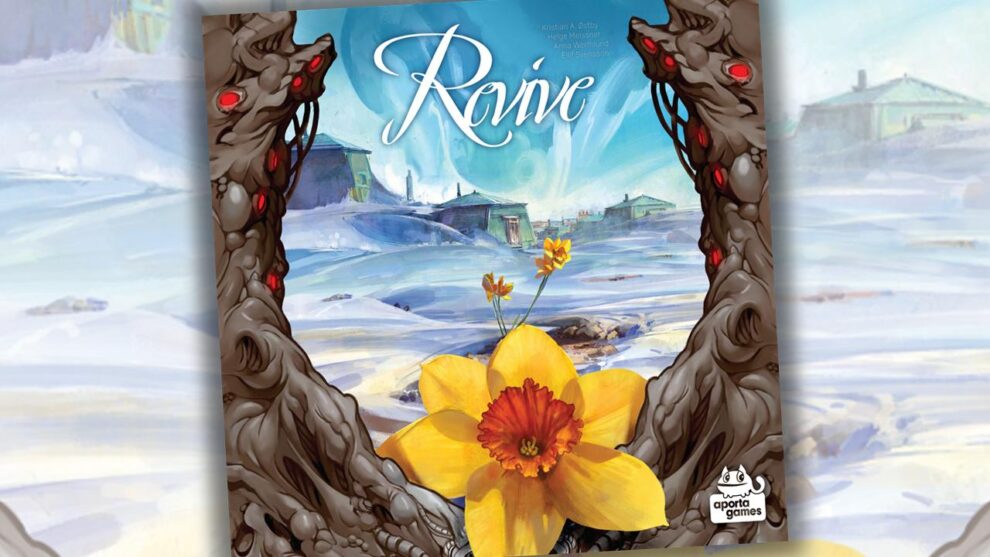

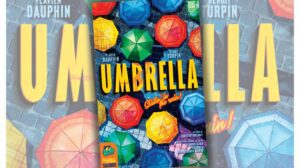


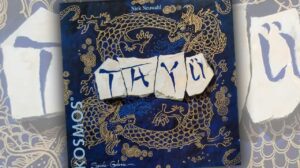


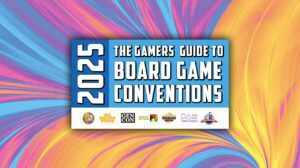
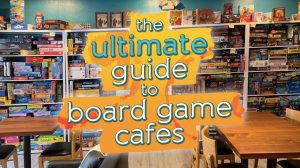
Add Comment